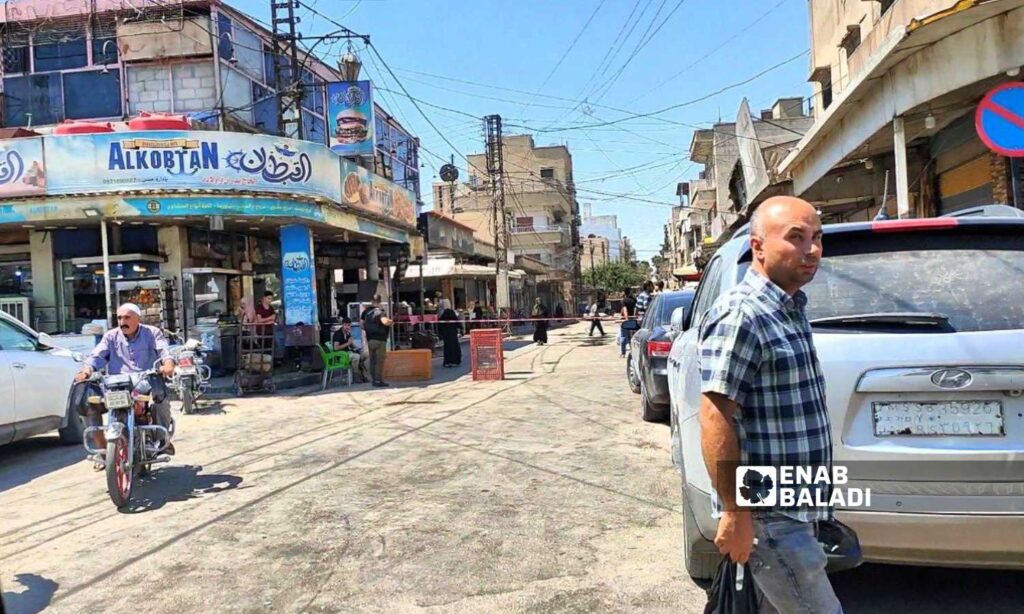The Syrian Democratic Forces (SDF) agreed to lift its siege on the security squares in al-Hasakah and Qamishli after an agreement with the regime under Russian mediation a few days ago. However, the implementation of the agreement was delayed in Qamishli, while it was immediately applied in the city of al-Hasakah.
Enab Baladi’s correspondents in al-Hasakah reported that the SDF began implementing the agreement immediately by withdrawing its elements and security checkpoints that it had set up on the streets surrounding the security square, including Palestine Street, the Great Mosque, and the square. They allowed the free movement of individuals and vehicles, particularly water tankers.
In Qamishli, the agreement was not fully implemented until the evening of Wednesday, August 14, as the SDF withdrew a small number of its elements from the area surrounding the security square between al-Hamam and al-Quwatli streets, east and west of the city. Additionally, they withdrew other elements from al-Raees Street south of the security square to the Turkish border north of the city.
SDF elements remained deployed on al-Raees Street, and the forces set up a military point opposite each point where regime forces are stationed, and on the parallel street to al-Raees until 11 pm on Wednesday when the SDF withdrew all its elements and lifted the siege on the security square in Qamishli.
Unlike al-Hasakah, the security square in Qamishli, which includes the recruitment office, military security, military judiciary, and party headquarters, does not include a large number of civilian residents.
Enab Baladi correspondents reported that the SDF also besieged al-Baath bakery near the municipal stadium, which supplies the security square and the military regiment with bread, and prevented it from receiving flour. However, they lifted their siege on it on Wednesday as well.
They also allowed the entry of cars and individuals to and from the regime-controlled areas in the southern countryside of Qamishli through the Zanoud checkpoint south of the Tay neighborhood in Qamishli.
What did the parties agree on?
The regime forces and the SDF reached a preliminary conditional agreement under Russian mediation to lift the siege on the security squares in the cities of al-Hasakah and Qamishli on August 13. However, the SDF conditioned the cessation of attacks in Deir Ezzor to start implementing the agreement.
The regime-affiliated newspaper Al-Watan reported that the SDF lifted its siege on the neighborhoods in the center of al-Hasakah and allowed water tankers to enter through the crossings leading to the security square.
The Beirut-based Al-Mayadeen channel quoted al-Hasakah governor, Luay Sayouh, saying that Russian mediation succeeded in ending the tension in the cities of al-Hasakah and Qamishli, noting that the SDF began opening the closed roads and water tankers and food supplies would gradually enter.
Enab Baladi’s correspondent in al-Hasakah stated that there was no change in the security deployment around the security squares until the day following the agreement, amid circulated news in the region that the siege was nearing its end.
A military source in the SDF who was present at Qamishli Airport during the negotiations between the SDF and the regime under Russian mediation told Enab Baladi in a previous conversation that the parties had reached a conditional agreement. This involved lifting the siege with Russian guarantees on the condition that the attacks in Deir Ezzor do not repeat.
The source, who agreed to speak to Enab Baladi on condition of anonymity, added that a convoy of water tankers would enter the center of al-Hasakah to fill the tanks on the streets, and flour and food supplies would be allowed to enter in the coming hours without changing the security deployment in the area.
The SDF forces will not move from the vicinity of the security square until Russia works to stop the attacks of the regime-supported groups east of Deir Ezzor.
The source expected the return of the siege in the event of any new attack in Deir Ezzor province, and the security square may witness military escalation if the agreement is breached, according to his expression.
Root of the problem
The SDF decision to impose a siege came as a response to attacks launched by groups supported by the Syrian regime and Iran in Deir Ezzor, resulting in the death and injury of mostly civilians.
The clashes between the two sides began in the middle of last week after the regime forces, supported by the National Defense and Tribal Forces, launched an attack on SDF positions in the eastern countryside of Deir Ezzor, causing large-scale displacement from the area.
The clashes continued until yesterday, Wednesday, according to Enab Baladi‘s reporter in the region.
On Thursday, the United Nations Office for the Coordination of Humanitarian Affairs (OCHA) commented on the clashes in Deir Ezzor, eastern Syria, which affected the delivery of aid and essential services to civilians in Deir Ezzor and al-Hasakah governorates.
OCHA mentioned in a report that Deir Ezzor witnessed intense clashes and sniping operations, leading to the death of at least 25 civilians, the injury of others, and large-scale displacement.











